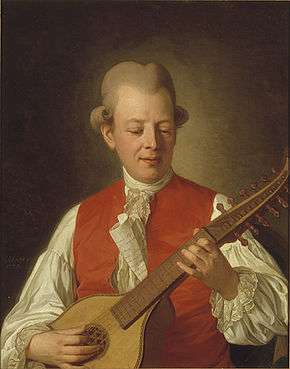I går såg jag ditt barn, min Fröja
 |
Melody of Epistle 28
|
| Problems playing this file? See media help. | |
I går såg jag ditt barn, min Fröja (Yesterday saw I your child, my Freya), is one of the Swedish poet and performer Carl Michael Bellman's best-known and best-loved songs, from his 1790 collection, Fredman's Epistles, where it is No. 28. The song describes an attempt to arrest the "nymph" Ulla Winblad, based on a real event. The lyrics create a rococo picture of life, blending classical allusion and pastoral description with harsh reality.
The epistle is subtitled "Om et anstäldt försåt emot Ulla Winblad." (About an ambush of Ulla Winblad).
Context
Carl Michael Bellman is the central figure in Swedish song, known for his 1790 Fredman's Epistles and his 1791 Fredman's Songs. He played the cittern, accompanying himself as he performed his songs at the royal court.[1] Jean Fredman is a fictional character and the supposed narrator in Bellman's epistles and songs, based on a real watchmaker of Bellman's Stockholm.[2] The epistles paint a picture of the demimonde life of the city during the eighteenth century, where strong drink and beautiful "nymphs" like Ulla Winblad create a rococo picture of life, blending classical allusion and pastoral description with harsh reality.[1][2]
Song
_-_03.jpg)

The song has five verses, each of 8 lines. The verses have the alternating rhyming pattern ABAB-CDCD. The music is in 3/4 time, and is marked Andante.[4] The melody was reworked by Joseph Martin Kraus from a Languedoc folk tune; it is accompanied throughout by rapid, nervous quavers (eighth notes), giving the Epistle in Edward Matz's view a cinematic slow motion effect.[5] The melody was used by "several parodists" in the 18th century; it had timbres including "Quoi-" and "Ah! ma voisine, es-tu fâchée?" which the musicologist James Massengale suggests Bellman may have had in mind.[6]
Bellman's biographer, Paul Britten Austin, describes the Epistle as rococo, along with No. 25: Blåsen nu alla (All blow now). In it, Ulla Winblad, "a luxuriant Venus, incarnation of love and beauty" is almost caught by the police in Yxsmedsgränd, a narrow street in Stockholm's Gamla stan, where Bellman himself lived from 1770 to 1774. The epistle describes how she just manages to escape. Bellman simultaneously uses classical and contemporary imagery. He calls Ulla a nymph; she has been given a "myrtle" (crown of leaves) by Freya, the Nordic goddess of love; the Bondeska palace (visible from the corner of Yxsmedsgränd) is called the temple of Themis, classical goddess of justice; and Freya is to be worshipped in Paphos' land, equating her with Venus/Aphrodite. Paphos in Cyprus was where, in the myth, Aphrodite rose naked from the foaming sea, and her temple is nearby. But, non-mythologically, Ulla wears "a black embroider'd bodice" and petticoats with "frills and laces", and she loses her watch in the struggle. Britten Austin translates the entire Epistle.[7][5]
Reception
Epistle 28 has been recorded by Cornelis Vreeswijk among others.[8]
References
- 1 2 "Carl Michael Bellmans liv och verk. En minibiografi (The Life and Works of Carl Michael Bellman. A Short Biography)" (in Swedish). The Bellman Society. Retrieved 25 April 2015.
- 1 2 Britten Austin, 1967. Pages 61–93.
- ↑ Britten Austin, 1967. facing page 88
- ↑ Bellman, 1791.
- 1 2 Matz, Edward (2015). Carl Michael Bellman: Nymfer och friska kalas (in Swedish). Svenska Historiska Media Förlag. pp. 30–32. ISBN 978-91-7545-218-0.
- ↑ Massengale, page 171
- ↑ Britten Austin, 1967. Pages 86–88.
- ↑ Hassler, page 284.
Sources
- Bellman, Carl Michael (1790). Fredmans epistlar. Stockholm: By Royal Privilege.
- Britten Austin, Paul. The Life and Songs of Carl Michael Bellman: Genius of the Swedish Rococo. Allhem, Malmö American-Scandinavian Foundation, New York, 1967. ISBN 978-3-932759-00-0
- Britten Austin, Paul. Fredman's Epistles and Songs. Stockholm: Proprius, 1990 and 1999.
- Hassler, Göran; Peter Dahl (illus.) (1989). Bellman – en antologi [Bellman – an anthology]. En bok för alla. ISBN 91-7448-742-6. (contains the most popular Epistles and Songs, in Swedish, with sheet music)
- Hassler, Göran; Peter Dahl (illus.) (1989). Bellman II – en antologi [Bellman – an anthology]. En bok för alla. ISBN 91-7448-837-6. (contains the remaining Epistles and Songs, in Swedish, with sheet music)
- Kleveland, Åse; Svenolov Ehrén (illus.) (1984). Fredmans epistlar & sånger [The songs and epistles of Fredman]. Stockholm: Informationsförlaget. ISBN 91-7736-059-1. (with facsimiles of sheet music from first editions in 1790, 1791)
- Massengale, James Rhea (1979). The Musical-Poetic Method of Carl Michael Bellman. Stockholm: Almqvist & Wiksell International. ISBN 91-554-0849-4.
